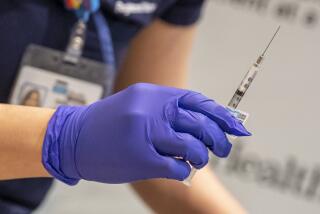New Vaccine May Combat Brain Tumors
- Share via
A UCLA-developed vaccine against a vicious form of brain cancer soon may join the growing list of anti-cancer vaccines now being tested in humans, researchers said Monday.
The vaccine proved 100% successful in tests against brain tumors in laboratory rats, the team reports today in the Proceedings of the National Academy of Sciences. Clinical trials could begin as early as this summer.
The new vaccine blocks the ability of brain tumor cells to secrete molecules that hide the cells from the patient’s immune system. Once the tumor is no longer hidden, the immune system can attack it.
The research could have implications far beyond brain cancer because the same shielding process occurs in prostate, breast, lung and colon cancers, said Dr. Habib Fakhrai of UCLA, who developed the vaccine with a team from UC San Diego.
The animal studies suggest that the approach will be effective for brain tumors, said Dr. Keith Black of UCLA, who also was on the research team.
Immunologist Carol Kruse of the University of Colorado Health Sciences Center said that even if the vaccine merely extends the life of brain tumor patients by a few months, “it is very significant. . . . There has been no good advance in brain tumor therapy in the last 20 to 30 years.”
At least five other cancer vaccines are now in clinical trials sponsored by the National Institutes of Health, and several biotechnology companies are sponsoring their own studies. Like the UCLA vaccine, the others are designed not to prevent cancer, like a conventional viral vaccine, but to bolster the immune system in patients who already have the disease.
Some successes have been reported in the preliminary trials, particularly with melanoma and lymphoma, but the entire field is still at a very early stage of development, experts agree. As is often the case with cancer drugs and other therapies, many cancer vaccines that have appeared promising in the laboratory have been disappointing in clinical practice.
Brain cancers strike about 13,000 Americans annually, killing 12,000. They are exceptionally difficult to treat, and the average expected life span after diagnosis is about nine months.
One reason brain tumors kill quickly is because they are able to hide from the immune system, Fakhrai said. They achieve this by secreting a protein called tumor growth-factor beta or TGF-B. “TGF-B cloaks the cancer cell so they are not recognized by the immune system,” Fakhrai said.
The researchers circumvented this problem by removing cells from the tumor and genetically engineering them so that they can no longer secrete TGF-B. The engineered cells are also irradiated so that they cannot multiply and form a new tumor.
The engineered cells then are injected into an arm or a leg, where they will not be shielded by TGF-B released by the brain tumor. Because they are not shielded, the immune system recognizes them as tumor cells and attacks them.
Once the cells provoke such an immune response, the immune system somehow is able to overcome the tumors’ shielding in the brain and to destroy tumor cells there.
Fakhrai’s team gave such a vaccine to 11 laboratory rats with actively growing brain tumors. All 11 animals survived for the 12 weeks of the experiment. Five animals given a placebo died within days.
In a further test, the researchers injected the vaccinated rats with 3,000 times the normally lethal dose of cancer cells. None of the animals developed tumors, indicating that the immune system retained a memory of the cancer cells and was able to recognize new ones.
Black said the team has gained approval from the National Institutes of Health to use the vaccine in humans and is awaiting permission from the Food and Drug Administration. Once team members receive approval, they will use it in 12 patients with glioblastomas, the most deadly form of brain cancer.
The team will isolate cells from a patient’s tumor after it is removed from the brain during conventional surgery. The team will engineer the cells and grow more in the laboratory during the six weeks that the patient will receive radiation therapy.
“We hope to have the vaccine available at the end of the six weeks,” Black said. “If we do, we will start giving shots of modified tumor cells to enhance immune function.”





